Were the most significant drops in financial markets a function of unstable free markets or government intervention?
Nassim Taleb, author of bestseller The Black Swan, often speaks on the danger of putting abnormal events in tidy boxes. Readers should be aware that there are many factors influencing markets at any given time, and by assigning a narrative we discount the role randomness plays in downturns. Keep this in mind as I attempt to outline the causes of most massive market crashes of the last 100 years. (Scroll to bottom for TL;DR for all you ADHD kids.)
1929: The Great Depression

"During the four days of the crash [(Oct. 24 - Oct. 29, 1929)], the Dow Jones Industrial Average dropped 25 percent and investors lost $30 billion. That was 10 times more than the 1929 federal budget. It was more than the United States spent on World War I. " (TheBalance)
Investors back then had to write on physical paper to execute trades. Following several red days of trading, at the stock market open on October 29 traders began selling, with the opening print signaling the Dow down 8 points or 3.2%. Within "a half hour, they sold three million shares and lost $2 million... the ticker tape that announced stock prices was hours behind." (TheBalance) This caused investors to panic sell, with no one knowing exactly where the price was; everyone was trying to sell at once. Large banks stepped in to stem the damage, but investors took this as a sign that the banks themselves were worried about their liquidity, triggering further selling.
The Federal Deposit Insurance Corporation (FDIC) didn't exist at the time (insurer for banks), so banks became insolvent as everyone rushed to take out their savings. Massive amounts of wealth were destroyed. The Fed had no idea what it was doing either, nor could it, with available information, technology, and monetary dynamics. The gold standard was still in force, so investors began to exchange dollars for gold; the government began to worry it would run out or gold reserves. To protect the dollar, the Fed increased interest rates into 1930; this had the secondary effect of making borrowing money much harder (less borrowing = slower growth).
Overnight Loan Rates 1920's:

At the same time, they cut the dollar's value relative to gold from $20.67/oz. in to $32.32/oz. in 1933, then $35.00/oz in 1934 (onlygold). That's a depreciation of the dollar on a global scale of 41% in two years.
Ouch.
Directly impacting purchasing power of US consumers, what used to be good for $100 of goods in 1932 was good for $59 in 1934. Imports dropped off a cliff while internal business starts were choked by high interest rates. The economy was crushed by governmental inadequacy.
The modern day policy of fiscal stimulus during recessionary times was introduced by Maynard Keynes; "What distinguishes Keynesians from other economists is their belief in activist policies to reduce the amplitude of the business cycle, which they rank among the most important of all economic problems" (IMF). This school of thought advocated government intervention to stem the highs and curb the lows of the economic cycle, creating a more stable environment. This idea stems from Keynes's collection of works published from 1930-1936, after the Great Depression. Sadly, no one had thought of governmental stimulus to save the economy yet in 1929, instead opting for monetarist policies based on the value of currency.
Nobel Prize winner Milton Friedman writes in Capitalism and Freedom, "... the severity of each of the major [economic] contractions... is directly attributable to acts of commission and omission by the [Federal] Reserve authorities and would not have occurred under earlier monetary and banking arrangements. There might well have been a recession on these or other occasions, but it is unlikely that any would have developed into a major contraction."
Conclusion: The spark of the Great Depression was caused by market inefficiencies in esoteric trading systems, but the Depression itself was caused by incompetent knowledge and use of power following the collapse of the stock market. Thus both free markets and governmental regulatory bodies are to blame for this economic crisis. The Dow lost 89% of its value over 846 trading days from Aug. 30, 1929 to July 7, 1932.
1937: New Deal Recession of 1937-38

Franklin Roosevelt signed the string of New Deal reforms from 1933-1936 in response to the Great Depression. Programs like the Civil Works Administration and the Works Progress Administration designed to stimulate the economy by bringing the unemployed back into the workforce, funding projects like the San Francisco-Oakland Bay Bridge, and LaGuardia Airport. (Wikipedia)
Keynesian economists argued he didn't do enough for the economy and ran too tight a budget. In order to curb spending, the US Government cut funding to some of these social programs. Perhaps accentuated by the normal business cycle, lack of commitment from the US Government is widely accepted to be a cause of the market collapse.
Conclusion: This was only a few years after the 1929 crash, and was a bit of a hangover from the pain of the early 1930's. While the US Government caught on that fiscal stimulus was a good idea, they didn't do enough. The Dow Jones lost 49% of its value over 321 trading days from March 3, 1937 to May 31, 1938.
1962: Kennedy Slide
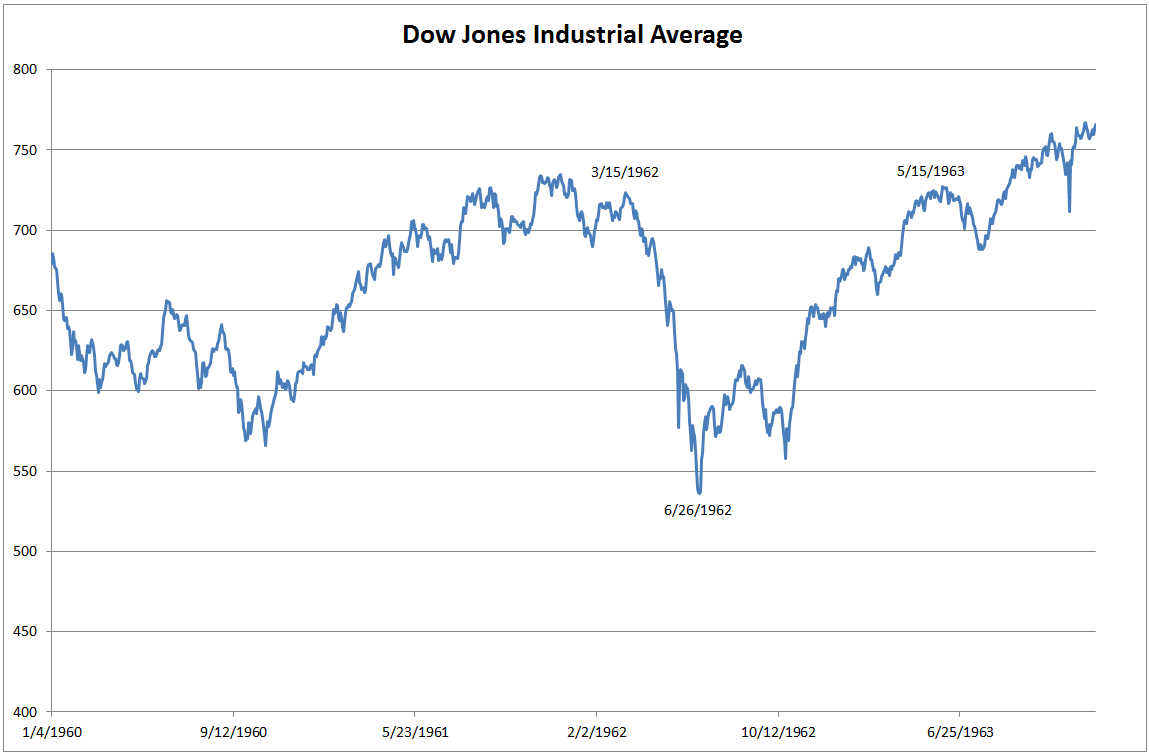
"'The stock market careened downward yesterday,' reported The Wall Street Journal on May 29, 1962, 'leaving traders shaken and exhausted.' The Dow Jones Industrial Average fell 5.7% that day, down 34.95, the second-largest point decline to date. 'The drop took place on volume so heavy,' added the Journal, that the 'ticker wasn't able to finish reporting floor transactions until 5:59 p.m., two hours and 29 minutes after the market closed.'" (WSJ)
This crash was caused by a blend of investor psychology and messy trading strategies/regulations. Market "specialists" were required by regulators to intervene when markets were behaving irrationally, but according to the SEC's investigation report, "'At no time during the day did the specialist intervene in sufficient volume to slow the rapid deterioration of the market in IBM (NYSE:IBM).'" (WSJ)
There was also a degree of herd mentality going on in large tech stocks. "...In 1961, stocks had risen 27%, with leading technology stocks like Texas Instruments (NASDAQ:TXN)... trading at up to 115 times earnings." This was not without reason; ComputerHistory.org reports, "By the mid-1960s, nearly half of all computers in the world were IBM 1401s."
This was the era of the Kennedy Assassination (Nov. 1963), and the Cuban Missile Crisis (Oct. 1962); the automatic pinsetter was introduced in bowling in 1961, leading to massive popularity of Brunswick stock. "All of this ebullience was reflected in the stock prices of bowling companies such as Brunswick Corporation, which according to the Wall Street Journal increased 1,590% between 1957 and its 1961 peak." (Quartz)
What a time to be alive.
Conclusion: Investor behavior was responsible, thus irrational market behavior prevailed. This was a function of the free market. The DJIA lost just under 26% of its value over 72 trading days from March 15 to July 26, 1962; notably, the market recovered to former levels by May 1963.
1987: Black Monday

This crash resulted from a balance of three factors: Portfolio Insurance, Algo Trading, and Investor Sentiment.
Portfolio insurance is popular with institutional investors. Large institutions that hold index futures (i.e. are long the market) sell index futures to hedge their directional risk, meaning their profits are not driven by a certain directional movement in the index. This is called "shorting" index futures to hedge, aka shorting the market to hedge a long exposure. Mutual funds operate under this framework. They promise the value of your portfolio won't drop below a certain level in exchange for a fee. These were popular before the time of the 1987 crash, and are still in use today (albeit with more regulatory scrutiny).
Investors also widely use what are called stop-loss orders that automatically execute a sale of the stock or index once a certain price level is hit. These help to protect gains or against losses should a sell-off occur. In the days leading up to the crash (Oct. 5th - Oct. 16th), the DJIA fell nearly 15%. As prices began to drop preceding Black Monday, portfolio insurance trigger levels came into play and set stop losses came closer and closer to execution. Once the selling started, many of these levels were hit, causing further selling.
Automatic computer-driven trading was still a new idea at this time. Never had such high-frequency trading been used, as it is today. Algorithmic trading hadn't been tested in a fast falling market. Sell orders flooded markets as algo strategies hit their loss limits and caused a domino effect as stop-losses were wiped out. The automated strategies were also programmed to take away their bid (buy) orders once certain limits were hit, so buyers seemingly vanished from markets, causing more panic.
The nasty combination of free market inventions such as portfolio insurance and algo trading and investor panic caused the Black Monday crash; Nobel Laureate and Yale Professor Robert Shiller predicted at the time that it could happen again. Portfolio insurance and stop-loss orders weren't a new invention at the time, so Shiller concluded that the selling was fueled by investor sentiment i.e. panic selling. This was a function of free markets. The DJIA lost just over 34% of its value over 12 trading days from October 5th to October 19th, 1987.
1990: Iraq invades Kuwait

By 1979, "inflation was running at an annual pace of about 9 percent", compared to just over 2% today. Paul Volcker "explained the FOMC would shift its focus to managing the volume of bank reserves in the system instead of trying to manage the day-to-day level of the federal funds rate (Lindsey et al. 2005). It was an approach that would lead to more fluctuation in rates and, Volcker hoped, rein in inflation." (FedReserveHistory) This marked the dawn of bond trading, as it is today. The bond market exploded, as investors could profit from swings in interest rates in the shorter term rather than just buying and holding to maturity.
"American governments, consumers, and corporations borrowed money at a faster clip during the 1980s than ever before; this meant the volume of bonds exploded... The combined indebtedness of the three groups in 1977 was $323 billion, much of which wasn't bonds but loans made by commercial banks. By 1985 the three groups had borrowed $7 trillion." (Michael Lewis, Liars Poker, Ch.3).
In the late 80's, consumers began to feel the weight of their excessive borrowing. The Fed had risen it's Fed Fund's Rate to 9.75% in 1988, trying to curb the rate of inflation in the US economy (TheBalance). This slowed borrowing, then consumption, then inflation. Markets responded. Consumer and business confidence began to flounder in the face of high interest rates. Markets continued to fall through July into August.
On Aug. 2nd, 1990, Iraq bombed the Kuwaiti capital, Kuwait City. This caused oil prices to skyrocket, rising 65% between August 3 and October 11th (chart below). Perhaps coincidentally, the date of the oil price top was also the low of the Dow in 1990.
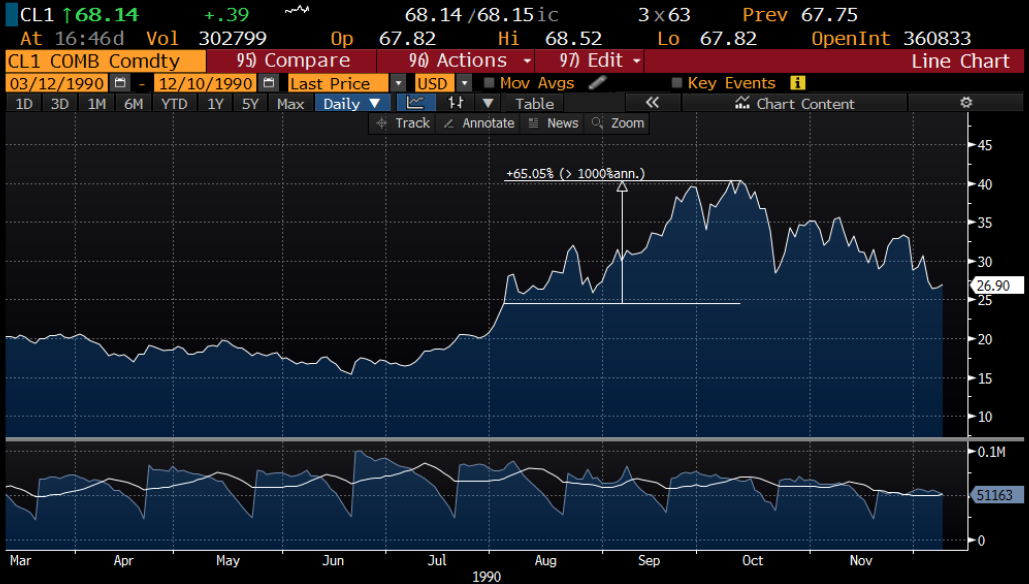
This was a function of free market business cycles as credit became overwhelming for the US economy. Consumers and business lost confidence in future growth prospects and geopolitical factors deepened the crash. The DJIA lost just over 21% of its value over 63 trading days from July 17th to October 11th, 1990. The market recovered to previous levels within 6 months of the crash. BTFD.
2000: Dot-com Bubble
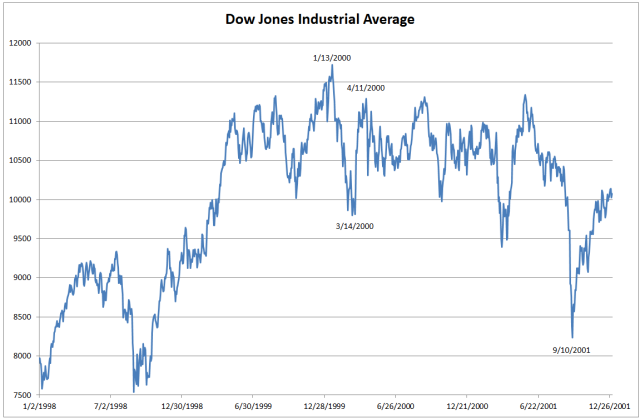
Unsurprisingly, this crash doesn't show much in the Dow Jones, as it is composed of an arbitrary selection of the largest companies in the US, few of which were technology based.
"Between 1990 and 1997, the percentage of households owning computers increased from 15 percent to 35 percent." (BLS.gov). This explosion in ownership of personal computers fueled a speculation bubble. Anything with a domain name was getting funded (publicly or privately) and spending gobs of that cash to accumulate a following, offering discounted or free product in exchange for clicks. For example, "On November 9, 2000, Pets.com, a much-hyped company that had backing from Amazon.com (NASDAQ:AMZN), went out of business only 9 months after completing its IPO." (CNN)
These tech companies would cash out via a quick IPO, then spend, spend, spend to gain a consumer following in hopes of turning a profit sometime in the distant future. Many failed, but sentiment was such that the public ate it up.
This crash was caused by investor sentiment, a derivative of free markets. The massive amount of speculation by the public looking for a get rich quick scheme caused the Nasdaq to fall just under 75% in the years following the excessive speculation from March 2000 to October 2002.
Also, see Enron and WorldCom, notable accounting scandals/bankruptcies declared in 2002.
2007-08: The Great Financial Crisis
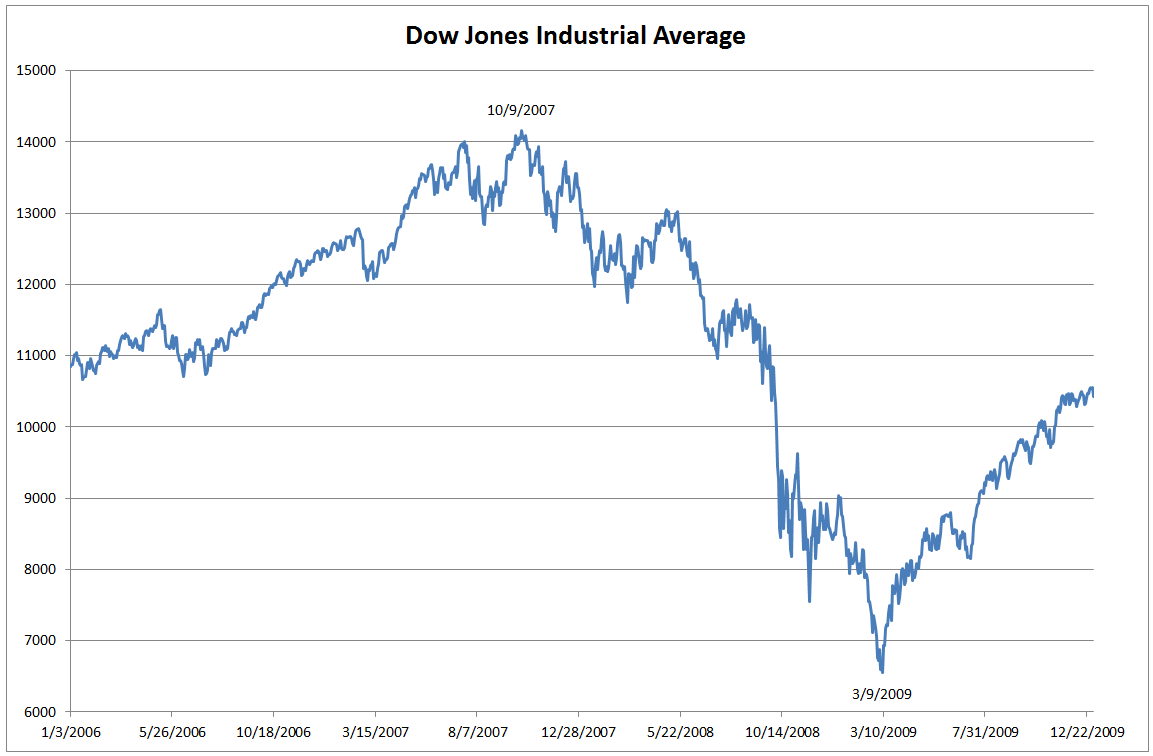
Ahh the GFC. Check out Too Big to Fail, the documentary covering the crisis and causes. Wildly entertaining.
The crisis was caused by investor speculation in real estate fueled by:
- Easy money (i.e. low interest rates).
- American Dream Downpayment Assistance Act which was signed into law by the Bush Administration in 2002; this allowed for homeowners to borrow more than the value of their homes (canceled in 2008).
- Incentive structures of investment banks, which were paid for the amount of loans they issued regardless of credit rating; they could then sell those mortgages to the Fannie Mae and Freddie Mac for a guarantee, making them effectively backed by the AAA-rated US Federal Government which has never defaulted...
- Structure of the mortgage credit derivatives, which, when appropriately used, allowed risk to be spread through the economy (note: still widely in use today).
- Wonky incentive schedules of mortgage brokers, similar to those of investment banks.
The real estate bubble was caused by lack of regulation and well-meaning but faulty incentives set by the Federal Government, which allowed for excessive speculation by global consumers. The rise began with the American Dream Downpayment Assistance Act, continued with wild investor sentiment and concluded in financial ruin worldwide. The DJIA fell just under 54%, or 38% annualized, over 356 trading days from October 9th, 2007 to March 9th, 2009.
Summary Table (TL;DR):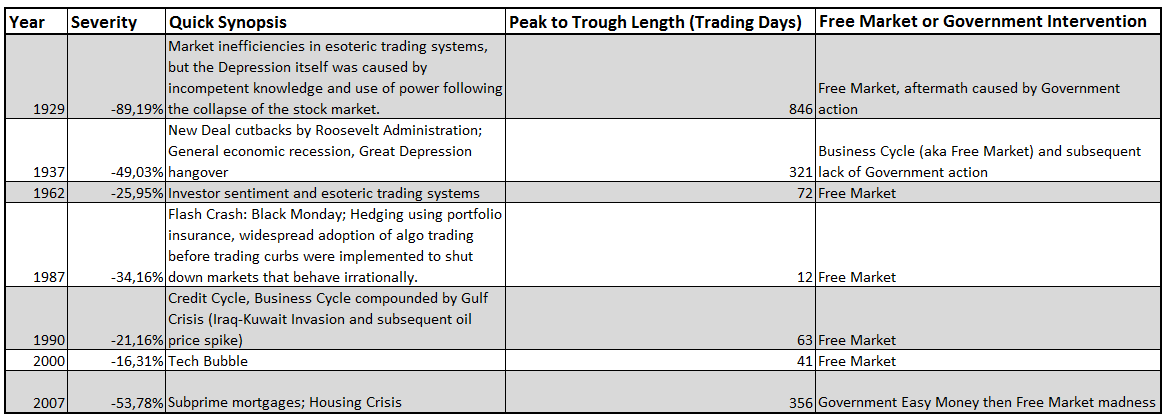
For all you diehard libertarians, free markets cause both booms and busts, with investor exuberance having a hand in EVERY market crash of the last 100 years. Mark Twain said, "history doesn't repeat itself, but it does rhyme." Understanding market conditions surrounding crises gives us an idea of what to look for, i.e. variables to watch. Let this be education rather than a guide for the next financial crisis.
Thanks for reading.
/tommander-in-chief
Thoughts or questions? Comment or send 'em over to fungiblethoughts@gmail.com.
Sauces:
- Dow Jones Industrial Average Data: https://www.measuringworth.com/datasets/DJA/result.php
- https://www.businessinsider.com/black-monday-dow-jones-industrial-average-1987-crash-shiller-2017-10?r=US&IR=T&IR=T
- https://www.federalreservehistory.org/essays/anti_inflation_measures
- https://www.thebalance.com/u-s-inflation-rate-history-by-year-and-forecast-3306093
